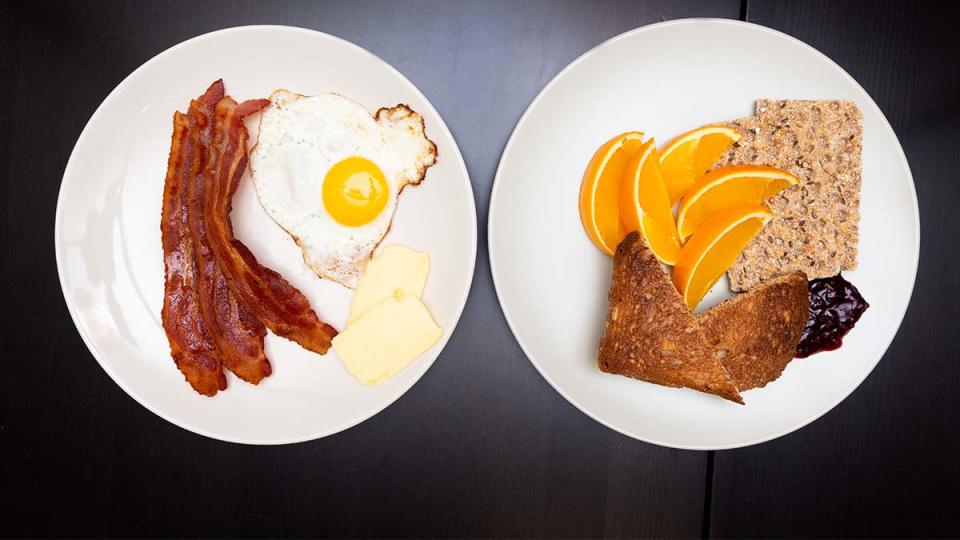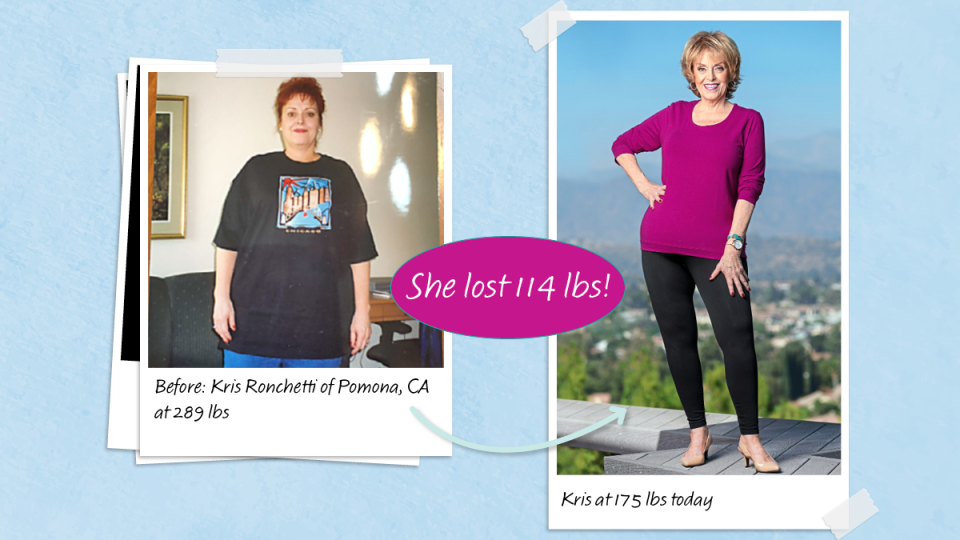What Is Metabolic Inflexibility? How To Overcome It and Lose Weight Over 50
There’s a reason we eat the same breakfast, shop the same route at the grocery store or order the same entrée at our favorite restaurants. We’re creatures of habit. And that goes for our diets, too. We know what healthy foods we like to eat so we stick with them, repeatedly enjoying a protein smoothie for breakfast, salad for lunch or grilled chicken for dinner. Despite our virtuous choices and ingrained habits, though, we watch as our midsections expand. It’s frustrating, but there’s a reason for it: When our diet lacks delightful surprises, our results do too. That’s why diet experts now recommend a strategy called metabolic confusion, which involves alternating between low and high calorie days — and including more carbs on the latter.
What is metabolic inflexibility?
When we’re young, our bodies are flexible in more ways than one. Not only can we bend and stretch with ease, but our bodies shift seamlessly from burning carbs and blood sugar during the day to burning stored fat at night. It keeps us energized and lean. The wrench in this very healthy system? In the modern world, we often eat so much food that turns to blood sugar, our bodies burn sugar all day and all night. We rarely burn any stored fat at all.
“We lose the ability to shift back and forth between efficiently burning fat or carbs,” explains Harvard-trained nutrition expert Ian K. Smith, MD, author of The Met-Flex Diet. “It’s extremely common for people, especially as we get older, to become metabolically inflexible.” Basically, our bodies get so out of practice at burning fat, they no longer do it properly.
How metabolic confusion turns back the clock
Thankfully, leading nutrition experts say it’s easy to restore our rigid metabolism to its youthful state with metabolic confusion. Instead of eating the same foods or calories every day, you alternate your choices to get the best weight-loss results.
“When the body is stuck at a plateau, you have to challenge it, physically and metabolically. You have to confuse it to lose it,” says Mike Moreno, MD, who advises shifting macronutrient ratios throughout the week. The popular new diet platform Noom also uses metabolic confusion in its plans.
“There’s a saying that goes, 'when you do the same thing over and over again and expect to get different results, that is the definition of insanity.' The same is true with our diet. This is where metabolic confusion can really help,” explains Anna Cabeca, DO, an osteopathic physician specializing in women’s health and weight loss. She instructs dieters to cycle between different eating patterns in her book MenuPause. This “confusion” concept is already well known in the fitness world, when people focus on either “leg days” or “arm days,” says Dr. Cabeca. People vary their exercises so they're not doing the same thing every day.
Metabolic confusion leads to fast fat loss
Dr. Ian is using the concept of metabolic confusion to help frustrated dieters. “The element of surprise that is so critical on the battlefield is also critical in the weight-loss battle,” he says. So he formulated a plan combining “cyclical keto” with intermittent fasting — two strategies proven to wake up a stalled metabolism, outlined in his book The Met Flex Diet. The three-time Ivy-League-educated doctor promises, “I have carefully combined strategies to yield maximal results.”
Utilizing the power of metabolic confusion can help you control your weight like a kid again. Dr. Ian explains, “A lot of people are eating some of the right things already. They’re just not eating them in the right pattern, at the right time. This is a more strategic approach.” His two-part metabolic confusion plan, which he created exclusively for FIRST, combines keto cycling plus fasting. It’s a surefire way to “lose a lot of weight, very quickly,” while eliminating diet boredom, says Dr. Ian.
Step 1 to restore metabolic flexibility: Try carb cycling
Each week of this metabolic-confusion diet starts with two high-carb days, followed by five low-carb or keto days. “It’s not like straight keto that says if you don’t stay in ketosis, you’re going to mess up. Here, you’re cycling in and out of keto,” explains Dr. Ian. You prime the body to get energy from carbs, then fat, and repeat the pattern. By quickly alternating between different food sources, the body becomes reacquainted with processing previously deprived food groups. Dr. Ian says, “The simple idea of switches acts as a rocket booster for metabolism.”
Frequent fuel switching is a powerful tactic for breaking through plateaus. And the delicious carb breaks — hello pizza and spaghetti! — prevent fat-packing stress-hormone flares than can occur under long-term carb restrictions. Dr. Ian adds, “People enjoy this program because of the diversity of the food. It really does not deprive you. You’re eating stuff you already like.”
Step 2: Add Intermittent fasting
Refraining form eating for roughly 16 hours in each 24-hour cycle — for example, from 7 PM to 11 AM — is the other key to this metabolic-confusion diet. Dr. Ian says this type of fasting or “time-restricted feeding” allows for all your meals and snacks to be focused within an 8-hour window of time, providing ample time for your system to rest and digest — and allow pounds to drop off!
In an Italian study, participants who followed this routine of fasting and feeding lost 423% more fat than those on a traditional eating schedule.
While fasting may sound daunting, millions of women have found it freeing. Charelle Smith-Davis dropped 180 pounds (40 pounds in 40 days) by skipping breakfast. She says, “I saved at least $100 a week on food from the store and restaurants.”
The world’s authority on intermittent fasting, Jason Fung, MD, concurs the practice can be a welcome change in busy life. “Unlike other interventions like exercise that require work, you get the benefits of fasting by simply not doing something.”
Why intermittent fasting is especially good for diabetics
Another reason to consider fasting? It can reduce the need for medication. Some 90% of study participants with Type 2 diabetes who followed intermittent fasting reduced their need for insulin and other blood-sugar lowering medications, according to research in the Journal of Clinical Endocrinology and Metabolism. Even better: 55% of participants achieved total diabetes remission and no longer needed medication.
“Insulin responds exceptionally well to intermittent fasting,” says nurse practitioner Cynthia Thurlow, author of Intermittent Fasting Transformation. “Food is the impetus for insulin secretion. But when you fast, your body naturally needs lower levels.” That’s good news for the wallet too. Researcher on the study Dongbo Liu, PhD, says, “Diabetes medications are costly…Our study saw medication costs decrease by 77% for people after fasting.”
What to eat on a metabolic-confusion diet

On Dr. Ian’s three week plan, you’ll practice “cycling keto” — two days of high-carb eating followed by five days of low-carb eating. This pattern wakes up a stuck-in-a-rut metabolism and restarts slimming as you move in and out of keto. Dr. Ian says, “Your body needs to be continuously surprised.”
On high-carb days
You'll devote 60 to 70% of your calories to carbohydrates, 15 to 20% to protein and 5 to 10% to fat, says Dr. Ian. During this time your body will be getting energy from the starches you eat. Consider oatmeal or fruit for a late breakfast, cheese pizza for lunch and spaghetti and meatballs for dinner.
On low-carb days
You'll get as much as 70 to 90% of your daily calorie intake from healthy fatty foods. (For best results, choose monounsaturated and polyunsaturated sources like avocados, eggs, olive oil, fish, flaxseed, full-fat dairy, nuts, seeds and olives). Make protein 10 to 20% of your calories, reducing processed meat, and the remaining percentage healthy carbs like fruit, veggies and quinoa. During this time, in the absence of carbs, Dr. Ian says, your body will be compelled to “move to plan B: burning fat.” Try an egg burrito for a late breakfast, Cobb salad for lunch and lamb chops for dinner.
Fit three meals and two snacks into each day, delaying breakfast and consuming everything within an 8-hour window of time. Choose whatever window works with your busy schedule. And avoid soda and added sugar on the plan.
Don’t forget snacks
Dr. Ian says frequent snacking promotes metabolic flexibility. He advises keeping snacks under 150 calories each and avoiding snacks within 1 hour of a meal. (Alternatively, you can eat both of your day’s snacks consecutively without a meal in between.) On high-carb days, consider snacks such as 2 scoops of sorbet, an English muffin with cucumber slices and cream cheese, ? cup of granola or ? banana dipped in chocolate. On low-carb days, try snacks such as 1 hardboiled egg, ? avocado stuffed with 3 oz. tuna, or bacon-wrapped asparagus.
How increased metabolic flexibility worked wonders for Kris

Draped in her hospital gown, Kris Ronchetti felt more vulnerable and uncomfortable than ever. She’d just heard a speech from her doctor about the importance of getting her health in order, and Kris worried, I just don’t feel like I will ever be able to lose this weight.
Kris finally felt a ray of hope when she learned about low-carb eating. For the first time in her life, she gained control of her appetite by eating satisfying foods like avocado and coconut oil. It wasn’t about restrictions or punishment. She also practiced carb cheat days where she could enjoy a dinner or dessert with friends. She recalls, “I didn’t get sick of it because the food was so good and I didn’t binge because I was always full.”
Within the first 2 or 3 months Kris was already down 25 pounds. She felt so nourished on this flexible keto-on-keto-off plan, she didn’t need to rush her breakfast. Instead she started with coffee (click through to learn more about protein coffee to lose weight) and waited until 10 A.M. to eat her first solid meal. It was perfect since she wasn’t a morning person. She also closed her kitchen around 6 P.M. each night. As the weight kept coming off, Kris noted, “It was a sign from the universe that I was on the right path.”
In all, Kris lost more than 100 pounds, got off her blood pressure meds, reversed her pre-diabetes, improved her thyroid function and elevated her post-menopausal moods. “It’s my passion to help women over 50 do this,” she says. “It’s not impossible to start over — no matter your age. Now I’m looking forward to my 80s!
Looking for more ways to speed a sluggish metabolism? Check out these stories
This Alternative to Intermittent Fasting Supports the Repair of Your Metabolism and Gut Health
The Best Way to Speed an Over-50 Metabolism? Denise Austin’s Strength Training Routine for Beginners
The Super Fruit Supplement That May Speed Heal Your Metabolism and Help You Lose Weight

Lisa Maxbauer is an award-winning health and nutrition writer at First for Women and Woman’s World magazines. She is a former guest blogger with The New York Times and author of the award-winning independent children’s book Squash Boom Beet. Learn more at SquashBoomBeet.com and follow on Instagram @lisamaxbauer.
This content is not a substitute for professional medical advice or diagnosis. Always consult your physician before pursuing any treatment plan.
A version of this article originally appeared in our print magazine, First For Women.
Solve the daily Crossword

